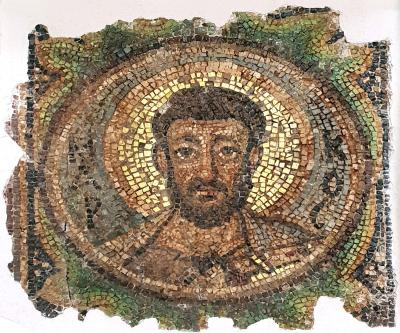Basic international humanitarian law (IHL) rules applicable to this situation:
Customary IHL
- Each party to the conflict must protect cultural property:
- All seizure of or destruction or wilful damage done to institutions dedicated to religion, charity, education, the arts and sciences, historic monuments and works of art and science is prohibited.
- Any form of theft, pillage or misappropriation of, and any acts of vandalism directed against, property of great importance to the cultural heritage of every people is prohibited.
First Protocol to the Convention for the Protection of Cultural Property in the Event of Armed Conflict (The Hague, 14 May 1954):
- Each High Contracting Party undertakes to take into its custody cultural property imported into its territory either directly or indirectly from any occupied territory. This shall either be effected automatically upon the importation of the property or, failing this, at the request of the authorities of that territory.
- Each High Contracting Party undertakes to return, at the close of hostilities, to the competent authorities of the territory previously occupied, cultural property which is in its territory, if such property has been exported in contravention of the principle laid down in Paragraph 1 of the First Protocol to the 1954 Hague Convention.
The case in brief
In 1958 the Netherlands was among the first countries to ratify the First Protocol to the 1954 Hague Convention for the Protection of Cultural Property in the Event of Armed Conflict.
In 1995, four Cypriot icons were discovered in the possession of a Dutch citizen. These had been removed from a Greek Orthodox church during hostilities in Cyprus in 1974 [since August 1974 Cyprus has been divided into two sectors: one in the south, under Greek-Cypriot control; the other in the north, controlled by the Turkish-Cypriot authorities].
At the request of the Cypriot government and in accordance with the Protocol, the Netherlands returned the icons to Cyprus.
IHL compliance highlights
- Upon receiving a formal request from the Cypriot authorities to return four icons in 1997, the government of the Netherlands acknowledged its obligation to return this property to Cyprus under the terms of the First Protocol to the 1954 Hague Convention.
- Recognizing that to take custody of the icons it must first introduce implementing legislation, the Netherlands adopted the Cultural Property Originating From Occupied Territory Act in 2007, with specific reference to this case.
- In 2013, the Netherlands officially returned the icons to Cyprus, exemplifying the commitment made by all State parties to the 1954 Hague Convention to respect the Convention and its Protocols.
Case prepared by Adinda van de Walle and Gabriele Kuchenbecker, LL.M. students at Leiden University under the supervision of Professor Robert Heinsch as well as Sofia Poulopoulou (PhD researcher), Johanna Trittenbach and Mahan Charmshir (research assistants), Kalshoven-Gieskes Forum, Leiden University.
A. NEW LEGISLATION ADOPTED BY THE NETHERLANDS ON THE PROTECTION OF CULTURAL PROPERTY
[Source: The Netherlands, Ministry of Education, Culture and Science, Explanatory Memorandum for the Cultural Property Originating From Occupied Territory (Return) Act 2007, AVT08/OCW92681A, 8 March 2007, p. 4-6, available at https://www.eui.eu/Projects/InternationalArtHeritageLaw/Documents/NationalLegislation/Netherlands/explanatorymemoandrulesforactcoveringoccupiedterritories2007.pdf]
1. Introduction
[…]
The purpose of the present Bill is to implement the Protocol. This is because the Protocol includes obligations, which, as will be seen below, necessitate the drawing up of statutory rules for the return of cultural objects taken from occupied territory. No such rules have yet been introduced.
[...]
2. The Netherlands and the Protocol
The Netherlands approved the Protocol for the Protection of Cultural Property in the Event of Armed Conflict by Act of 16 July 1958 [...] It was one of the first countries to ratify the Protocol. An instrument of ratification was deposited by the Netherlands with the Director-General of UNESCO on 14 October 1958.
[...]
3. Need for implementation
[…]
In the light of the case law referred to below, it must be assumed that the provisions of the Protocol do not have direct effect. This means that the possessor of a cultural object that must be returned to the country of origin pursuant to the obligations of the Protocol cannot be compelled on the basis of the Protocol to part with possession of it. In this situation forcible surrender is possible only if Dutch legislation itself contains provisions to this effect. Implementing legislation is therefore necessary.
The reason why it took so long for the need for implementation to be recognised was that the first request by a foreign authority to the Dutch government for the return of cultural objects was not submitted under the Protocol until 1997. […] The request for the return of the icons was made following civil proceedings instituted in 1995 by the Greek Cypriot church before Rotterdam District Court for their return. In its judgment of 4 February 1999 […], the District Court held that article 1.4 of the Protocol was not a provision binding on all persons within the meaning of article 94 of the Constitution. This judgment was upheld on appeal by The Hague Court of Appeal […]. The claim for the return of cultural objects on Dutch territory as referred to here was refused for this reason. The request of the Cypriot authorities for the return of the objects cannot be dismissed as a one-off event. In view of the many trouble spots in the world [...] it is by no means inconceivable that the Dutch government will receive more requests of the kind made by Cyprus.
The conclusion to be drawn from this is that the Netherlands can no longer wait to implement the Protocol in national legislation. Moreover, the Netherlands has always played a pioneering role in relation to the Convention, for example in relation to the introduction of the Second Protocol to the Convention, which was adopted in March 1999. […] It should be noted that inquiries made of UNESCO have revealed that, as far as is known, no other parties to the Convention have yet implemented the Protocol in the manner which the Netherlands is now doing.
[…]
B. THE NETHERLANDS REPATRIATES CYPRIOT ICONS
[Source: The Netherlands and Cyprus, ‘Mutual Presentation of Cyprus and the Netherlands on the return of 4 icons from the Netherlands to Cyprus under the Protocol of the Hague Convention of 1954’, 10th meeting of the High Contracting Parties to the Hague Convention, 16 December 2013, available at http://www.unesco.org/culture/laws/1954/NL-Cyprus-4icons_en]
The Netherlands:
On 18 September 2013, the Director General of Culture and Media of the Netherlands officially handed over four icons to the Ambassador of Cyprus. At this ceremony, which took place at the Ministry of Culture in The Hague, representatives of the Dutch and Cypriot governments, as well as the Greek Orthodox Church were present.
[...]
It was the first time the Netherlands returned cultural property under the First Protocol to the Hague Convention. It also appeared to be the first time a cultural property was returned under this Protocol in the world.
Cyprus:
[...]
Beyond the positive response and the great cooperation with the Dutch authorities, Cyprus acknowledges and welcomes the very important legislative measures that the Netherlands have taken to enhance the protection of cultural property from occupied territories. This also reaffirms the need to respect the provisions of the Hague Convention of 1954 and its Protocols by all contracting States.
The Government of Cyprus considers that cooperation between States in order to preserve cultural property in their context and original setting is of paramount importance, and the repatriation of these four icons is an emblematic example of this cooperation.
Icons of the Church of the Antiphonitis, Kalograia
The four ecclesiastical icons were returned to Cyprus by the Netherlands on 20 September 2013. They belong to the Church of Christ Antiphonitis located in the village of Kalograia (District of Keryneia), ie in an area of Cyprus that is not under the effective control of the Government of the Republic of Cyprus.
The church was built during the Byzantine period in the late 12th century, and was later modified in the 15th century.
However, following the events of 1974, most of these murals were cut into pieces, and the icons as well as the doors of the sanctuary were removed. [...]
Four icons representing the Evangelists John and Mark, and the Apostles Peter and Paul, dating from the 16th century, were found in May 1995. They were in the possession of a Dutch citizen who had bought them from a collector shortly after the invasion of 1974. [...]
Continuation of the intervention of the Netherlands:
The restitution was the conclusion of a long process that had started in May 2011 with a request from the Minister of Culture of Cyprus to the Minister of Culture of the Netherlands for the return of the four icons. At that moment these icons were in private possession.
The letter of the Minister of Culture of Cyprus did not come as a surprise. The requested objects had already been subject to a civil court case in the Netherlands in the 1990’s. At that time the judges concluded that on the basis of the existing law of the Netherlands, the icons could not be returned under civil law. The international legislation on which a return could be based, the First Protocol to the Hague Convention of UNESCO, did not have a direct binding effect on Dutch citizens.
This was an eye-opener for the Dutch government.
[...]
The Hague Convention was a reaction to what had happened in the Second World War. Not only had people been killed by bombs and warfare, but buildings, monuments and churches were also severely damaged on both sides of the battlefield. From the allied countries, works of art were looted systematically. In the chaotic situation after the war, works of art were taken to third places as war trophies.
Having experienced this, the Netherlands became one of the frontrunners in establishing the international standard-setting instruments which protect cultural property in times of conflict. As a consequence, when it appeared ten years ago that the Dutch law was inadequate in this respect, the Dutch Government found it of utmost importance to repair this omission. This resulted in the Cultural Property Originating from Occupied Territory (Return) Act of 2007.
Interestingly, in the Explanatory Memorandum to the Act, the case of the Cypriot icons was described as the immediate reason for its establishment. […]
[...]
At the ceremony of the transfer of the icons the Director General highlighted questions such as: Why has the international community made all these efforts? Why should these icons be returned? Why do we think this is so important? The answer is that cultural goods are connected to a country, to people, to their history. The presence of the Ambassador of Cyprus and the representatives of the Greek orthodox church of Cyprus at the ceremony demonstrated how these depictions of the four Evangelists are of value to them, to Cyprus, to their church and to the citizens of Cyprus.
[…]
Discussion
I. Classification of the Situation and Applicable Law
1. How would you classify the situation in Cyprus in 1974? What additional information would you require to make such a determination? (Hague Regulations, Art. 42; GC I-IV, Art. 2)
2. Was the Netherlands involved in the situation in Cyprus in 1974? If not, is it still bound by certain obligations under IHL? (First Protocol to the Hague Convention of 1954 for the Protection of Cultural Property in the Event of Armed Conflict, Para 1; 3)
II. Return of Illicitly Exported Cultural Property
3. Are states parties to the First Protocol to the 1954 Hague Convention under an obligation to return cultural property to territories from where it has been illegally exported? What is the temporal scope of this obligation? (First Protocol to the Hague Convention of 1954 for the Protection of Cultural Property in the Event of Armed Conflict, Paras. 2; 3)
4. What is the procedure governing the return of illicitly exported cultural property? Is it necessary that a request from the country of origin is issued? (First Protocol to the Hague Convention of 1954 for the Protection of Cultural Property in the Event of Armed Conflict, Para 3; 4)
5. What are the implementation measures that states need to undertake upon ratification of the First Protocol in order to bring its provisions in full effect? What is the relevant timeframe? (First Protocol to the Hague Convention of 1954 for the Protection of Cultural Property in the Event of Armed Conflict, Paras. 11)
III. Elements Contributing to Respect for IHL
6. (Document B) Do you agree with the statement that “cultural goods are connected to a country, to people, to their history”? In your opinion, does the handover of the artefacts in the presence of representatives of the Cypriot government and the Greek Orthodox Church demonstrate the value of the icons for Cyprus, its citizens and church? Does such presence of the representatives depict political pressure to return those cultural goods?
7. (Document B) Could the formal request by the Cypriot minister for the return of artifacts pressured The Netherlands to act? Did the judicial action brought by Cyprus?
8. (Documents A and B) Does the fact that a state has experienced the looting of its own cultural property during past armed conflicts contribute to its motivation to ratify international treaties regulating the protection of cultural property in armed conflict and adopt implementing legislation?
9. (Documents A and B) Do you consider that the Netherlands’ “pioneering role” in relation to the 1954 Hague Convention could have influenced the adoption of the new legislation in 2007? Can a public ceremony of return of artifacts be a way to publicize it? In your opinion, can public perception influence states’ conduct? Can it serve as motivation to address the shortcomings in the implementation of the First Protocol?






